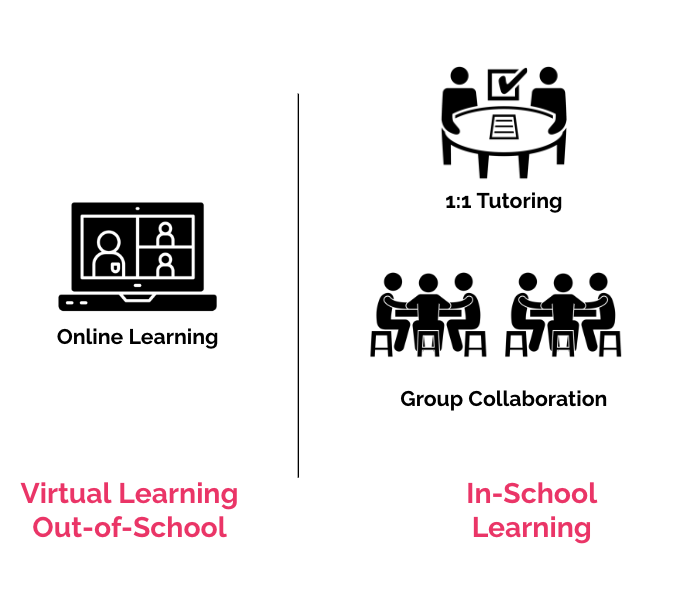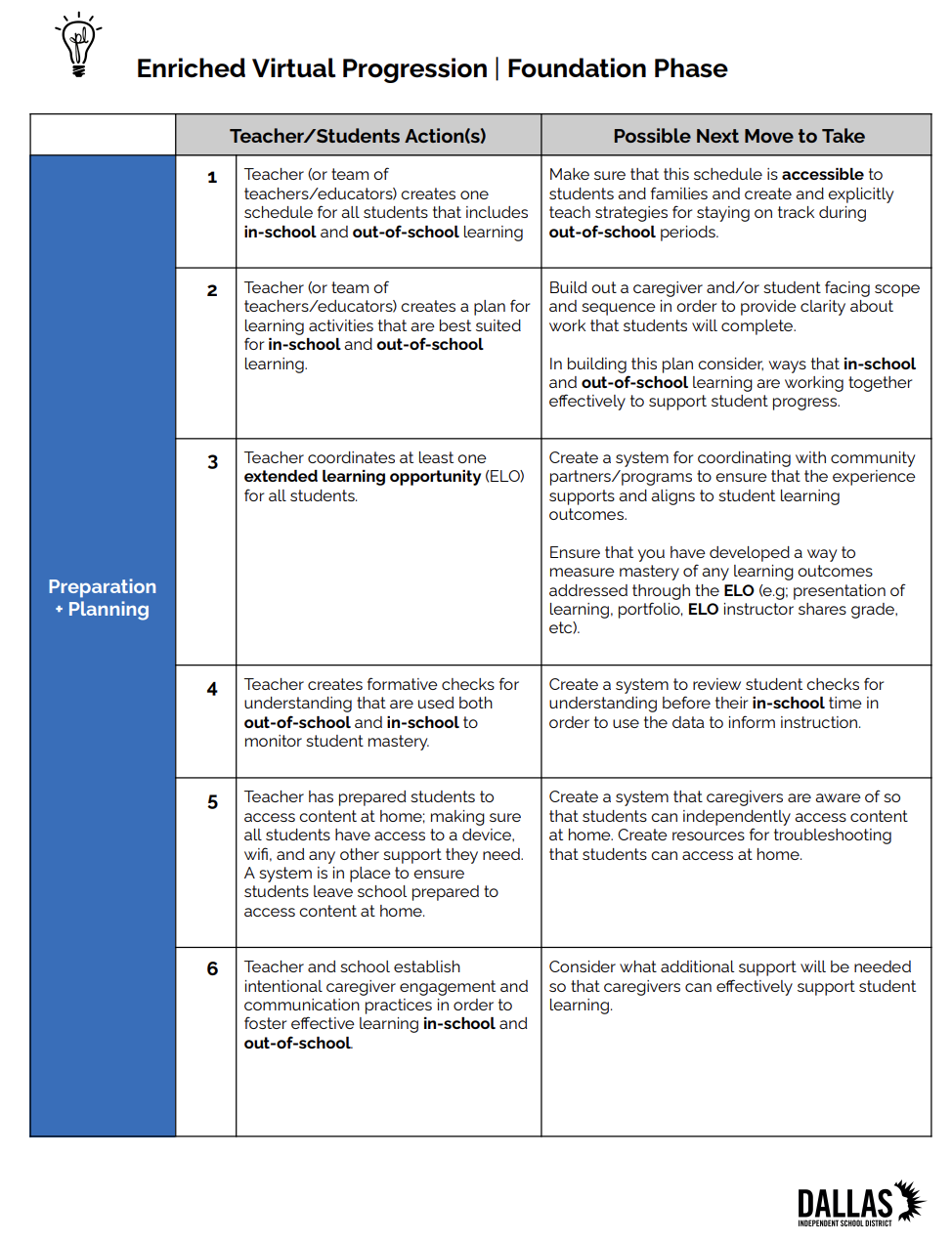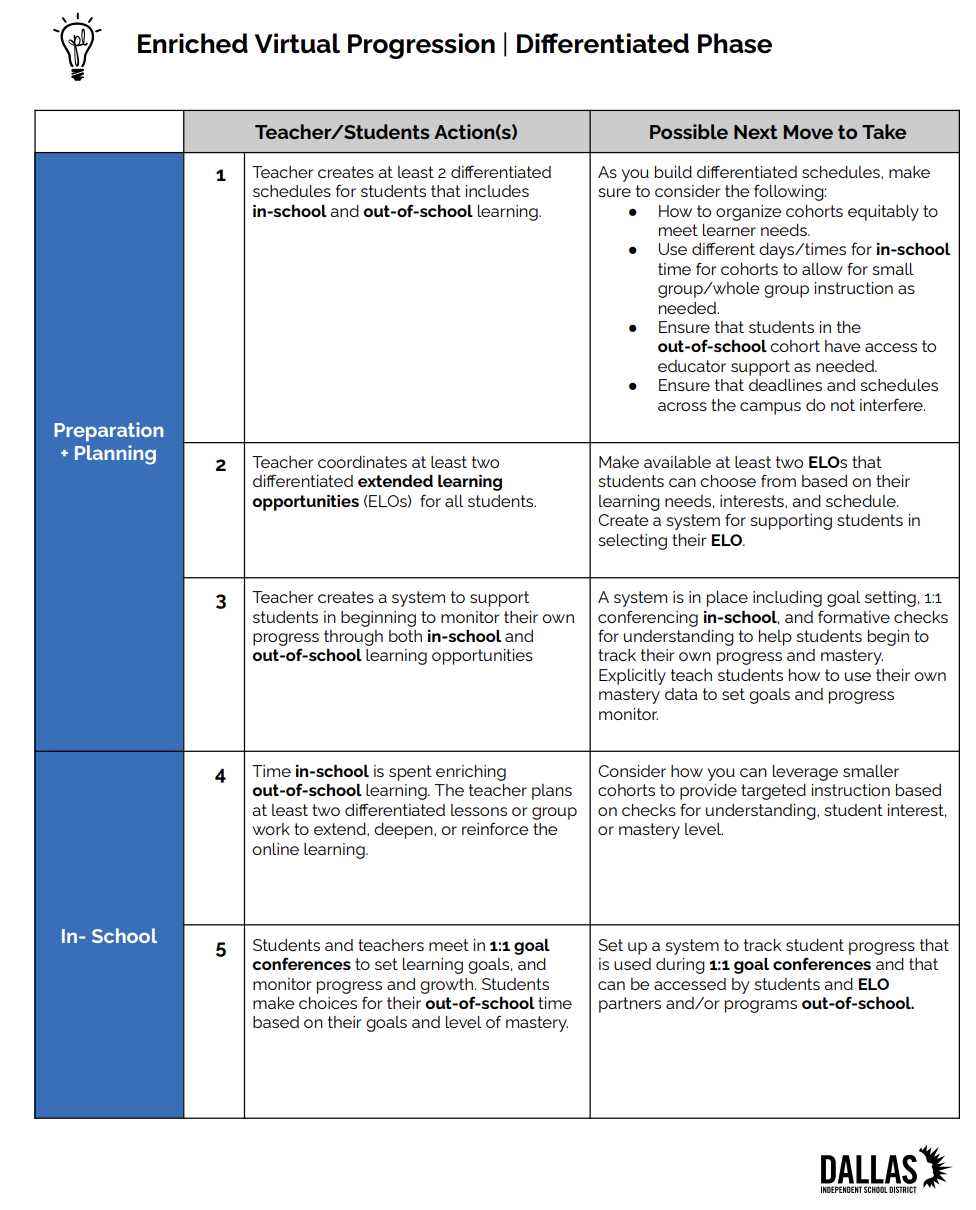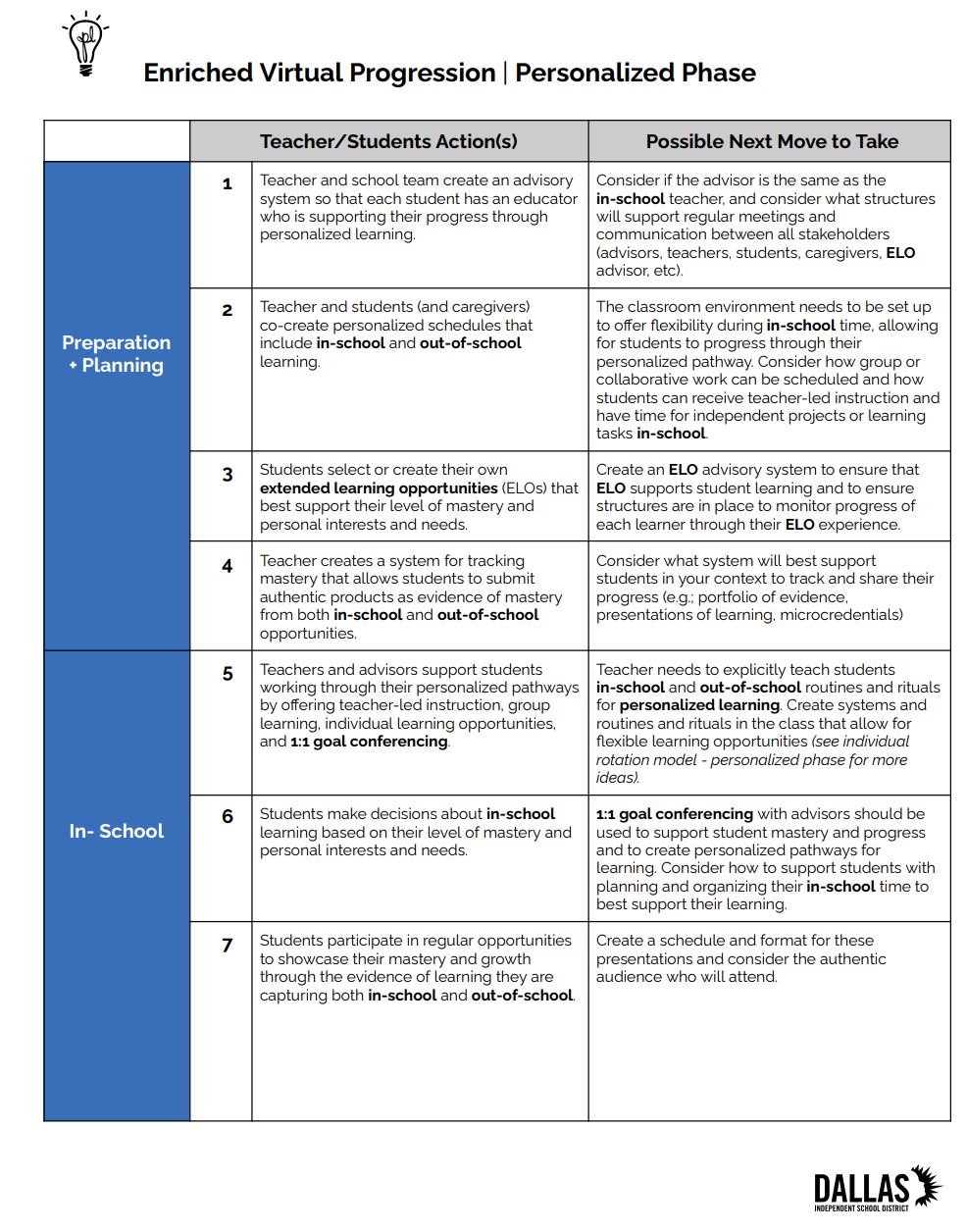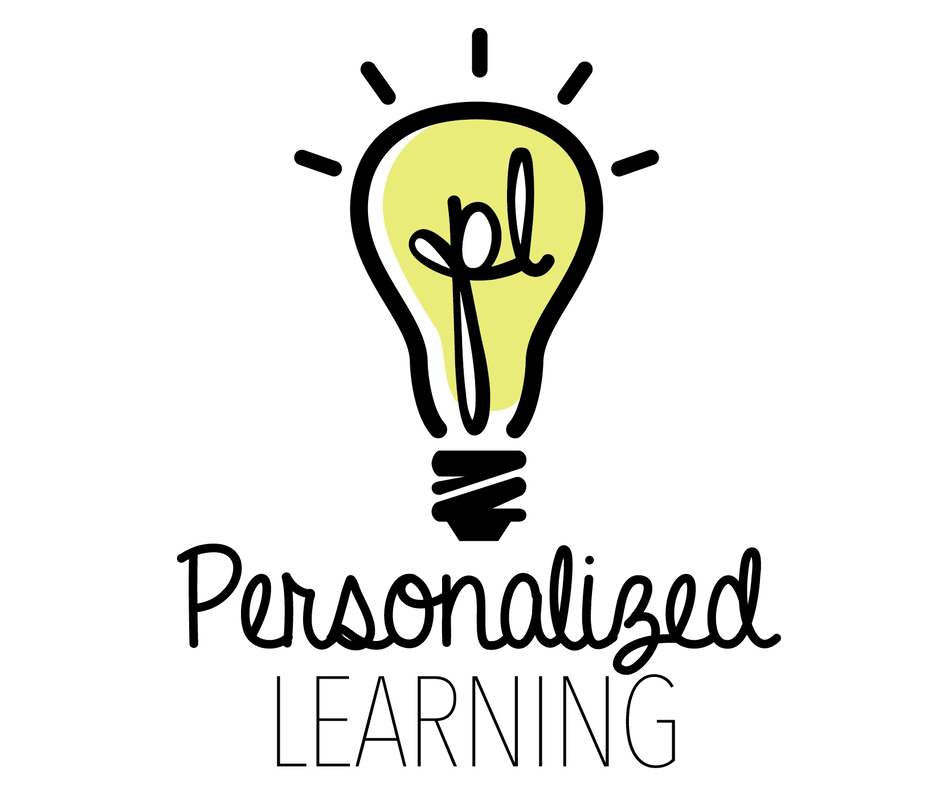The Enriched Virtual Progression is a tool that identifies the necessary steps to take when implementing a Blended Enriched Virtual Model
|
Enriched Virtual Model
Learn more about the Enriched Virtual Model by visiting the Blended Learning Universe at www.blendedlearning.org. |
|
|
A progression is a pathway a learner might take to reach the end goal or learning target. This tool is carefully sequenced across three phases of implementation:
|
|
Identifies the sequence of teacher and student actions that must be mastered in order to establish the foundation and readiness for an effective flipped classroom.
|
Identifies the sequence of teacher and student actions that enables differentiation in an effective flipped classroom.
|
Builds on the Foundation and Differentiated phases to identify the sequence of teacher and student actions that meet the need and interest of every learner.
|
Foundation Phase
Identifies the sequence of teacher and student actions that must be mastered in order to establish the foundation and readiness for an effective enriched virtual model.
Preparation and Planning
1. Teacher (or team of teachers/educators) creates one schedule for all students that includes in-school and out-of-school learning. |
Next Move: Make sure that this schedule is accessible to students and families and create and explicitly teach strategies for staying on track during out-of-school periods. |
|
2. Teacher (or team of teachers/educators) creates a plan for learning activities that are best suited for in-school and out-of-school learning. |
Next Move: Build out a caregiver and/or student facing scope and sequence in order to provide clarity about work that students will complete. In building this plan consider, ways that in-school and out-of-school learning are working together effectively to support student progress. |
|
3. Teacher coordinates at least one extended learning opportunity [ELO] for all students. |
Next Move: Create a system for coordinating with community partners/programs to ensure that the experience supports and aligns to student learning outcomes. Ensure that you have developed a way to measure mastery of any learning outcomes addressed through the ELO (e.g; presentation of learning, portfolio, ELO instructor shares grade, etc). |
|
4. Teacher creates formative checks for understanding that are used both out-of-school and in-school to monitor student mastery. |
Next Move: Create a system to review student checks for understanding before their in-school time in order to use the data to inform instruction. |
|
5. Teacher has prepared students to access content at home; making sure all students have access to a device, wifi, and any other support they need. A system is in place to ensure students leave school prepared to access content at home. |
Next Move: Create a system that caregivers are aware of so that students can independently access content at home. Create resources for troubleshooting that students can access at home. |
|
6. Teacher and school establish intentional caregiver engagement and communication practices in order to foster effective learning in-school and out-of-school. |
Next Move: Consider what additional support will be needed so that caregivers can effectively support student learning. |
|
In- School
7. Time in-school is spent enriching the out-of-school learning. Because this time is limited, teacher has planned key lessons or group work to extend, deepen, or reinforce the online learning. |
Next Move: Plan in-school learning to be high leverage and something students can’t do out-of-school. Assessments completed in-school are used with out-of-school checks for understanding to track student mastery. |
|
8. Time in-school can also include specials or other opportunities that are not offered to students out-of-school. |
Next Move: Work collaboratively with educators to create this schedule and consider how these opportunities can support the student’s out-of-school work. |
|
Out-of- School
9. Students complete online content through a secure learning management system. |
Next Move: Ensure that content is accessible by all students and that troubleshooting guides are available as needed. Consider what total amount of time students have for out-of-school learning and plan content accordingly. Explicitly teach students strategies for independent online learning, ensuring they know how to get support if needed. |
|
10. Students complete all tasks for their ELO. |
Next Move: Ensure that the schedule for the ELO is clear and practical for students to complete. |
|
11. Students complete all checks for understanding to track mastery of learning. |
Next Move: Provide explicit instructions to students for where to access, how to submit, and what to do to monitor their own learning. |
|
12. Teacher has a system to regularly monitor, review, and provide feedback on student out-of-school work. |
Next Move: If using an adaptive software program, use the teacher dashboard to monitor progress. If using teacher-created online content, review virtual checks for understanding (e.g., Google Forms, LanSchool). For ELOs, coordinate with a partner/program to ensure you are able to track student learning throughout the experience (can be through their program if that exists or you can create formative checks for understanding that they integrate into the experience). |
|
Differentiated Phase
Identifies the sequence of teacher and student actions that enables differentiation in an effective enriched virtual model.
Preparation + Planning
1. Teacher creates at least 2 differentiated schedules for students that includes in-school and out-of-school learning. |
Next Move: As you build differentiated schedules, make sure to consider the following:
|
|
2. Teacher coordinates at least two differentiated extended learning opportunities (ELOs) for all students. |
Next Move: Make available at least two ELOs that students can choose from based on their learning needs, interests, and schedule. Create a system for supporting students in selecting their ELO. |
|
3. Teacher creates a system to support students in beginning to monitor their own progress through both in-school and out-of-school learning opportunities. |
Next Move: A system is in place including goal setting, 1:1 conferencing in-school, and formative checks for understanding to help students begin to track their own progress and mastery. Explicitly teach students how to use their own mastery data to set goals and progress monitor. |
|
In-School
4. Time in-school is spent enriching out-of-school learning. The teacher plans at least two differentiated lessons or group work to extend, deepen, or reinforce the online learning. |
Next Move: Consider how you can leverage smaller cohorts to provide targeted instruction based on checks for understanding, student interest, or mastery level. |
|
5. Students and teachers meet in 1:1 goal conferences to set learning goals, and monitor progress and growth. Students make choices for their out-of-school time based on their goals and level of mastery. |
Next Move: Set up a system to track student progress that is used during 1:1 goal conferences and that can be accessed by students and ELO partners and/or programs out-of-school. |
|
Out-of-School
6. Teacher plans at least two differentiated online content lessons and/or uses adaptive software programs to provide differentiated learning opportunities to students out-of-school. |
Next Move: Use checks for understanding, student goals, interests, and mastery levels to plan for differentiated out-of-school instruction. |
|
7. Students complete differentiated online content through a secure learning management system. They use their goals to help make choices about content. |
Next Move: Offer students choices about what order they complete tasks and how they demonstrate their learning. |
|
8. Students participate in available ELOs as agreed upon with their teacher. |
Next Move: Student progress in ELO is aligned to their goals and is regularly communicated to teacher. |
|
9. Students track their progress by monitoring tasks completed, time spent, mastery of content. |
Next Move: Students and teachers share and review this data regularly during 1:1 goal conferences, using it to make decisions about learning and instruction. |
|
Personalized Phase
Builds on the Foundation and Differentiated phases to identify the sequence of teacher and student actions that meet the need and interest of every learner.
Preparation + Planning
1. Teacher and school team create an advisory system so that each student has an educator who is supporting their progress through personalized learning. |
Next Move: Consider if the advisor is the same as the in-school teacher, and consider what structures will support regular meetings and communication between all stakeholders (advisors, teachers, students, caregivers, ELO advisor, etc). |
|
2. Teacher and students (and caregivers) co-create personalized schedules that include in-school and out-of-school learning. |
Next Move: The classroom environment needs to be set up to offer flexibility during in-school time, allowing for students to progress through their personalized pathway. Consider how group or collaborative work can be scheduled and how students can receive teacher-led instruction and have time for independent projects or learning tasks in-school. |
|
3. Students select or create their own extended learning opportunities (ELOs) that best support their level of mastery and personal interests and needs. |
Next Move: Create an ELO advisory system to ensure that ELO supports student learning and to ensure structures are in place to monitor progress of each learner through their ELO experience. |
|
4. Teacher creates a system for tracking mastery that allows students to submit authentic products as evidence of mastery from both in-school and out-of-school opportunities. |
Next Move: Consider what system will best support students in your context to track and share their progress (e.g.; portfolio of evidence, presentations of learning, microcredentials). |
|
In-School
5. Teachers and advisors support students working through their personalized pathways by offering teacher-led instruction, group learning, individual learning opportunities, and 1:1 goal conferencing. |
Next Move: Teacher needs to explicitly teach students in-school and out-of-school routines and rituals for personalized learning. Create systems and routines and rituals in the class that allow for flexible learning opportunities (see individual rotation model - personalized phase for more ideas). |
|
6. Students make decisions about in-school learning based on their level of mastery and personal interests and needs. |
Next Move: 1:1 goal conferencing with advisors should be used to support student mastery and progress and to create personalized pathways for learning. Consider how to support students with planning and organizing their in-school time to best support their learning. |
|
7. Students participate in regular opportunities to showcase their mastery and growth through the evidence of learning they are capturing both in-school and out-of-school. |
Next Move: Create a schedule and format for these presentations and consider the authentic audience who will attend. |
|
Out-of-School
8. Teachers use agendas, playlists, or must dos and may dos to create personalized content that students can access out-of-school. |
Next Move: In creating these offerings consider where to include formative checks for understanding to ensure that students are mastering the content. |
|
9. Students use their personalized pathway to plan and monitor their learning, accessing online content through agenda, playlist, or must dos and may dos. |
Next Move: Teach students explicit strategies for managing and taking responsibility for their learning. Students make choices about their learning based on their level of mastery and personal interests and needs. |
|
10. Students participate in their own ELO, tracking their progress and mastery throughout. |
Next Move: Ensure that the advisory system incorporates ways for students to monitor and share their progress. Coordinate with community partners and/or programs to ensure alignment to this model of students self-monitoring progress. |
|
11. Students capture evidence of mastery both in all out-of-school experiences and submit this to their teachers. |
Next Move: Based on the system in place for tracking mastery (e.g.; portfolios of evidence, presentations of learning, microcredentials) teach students how to capture and submit evidence. |
|
| Enriched Virtual Extended Progression | |
| File Size: | 194 kb |
| File Type: | |
| Enriched Virtual Progression | Foundation Phase | |
| File Size: | 166 kb |
| File Type: | |
| Enriched Virtual Progression | Differentiated Phase | |
| File Size: | 165 kb |
| File Type: | |
| Enriched Virtual Progression | Personalized Phase | |
| File Size: | 174 kb |
| File Type: | |
